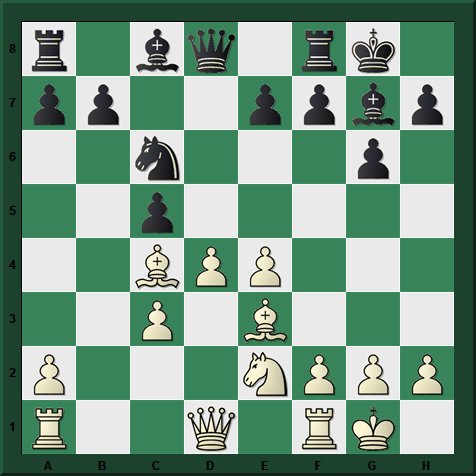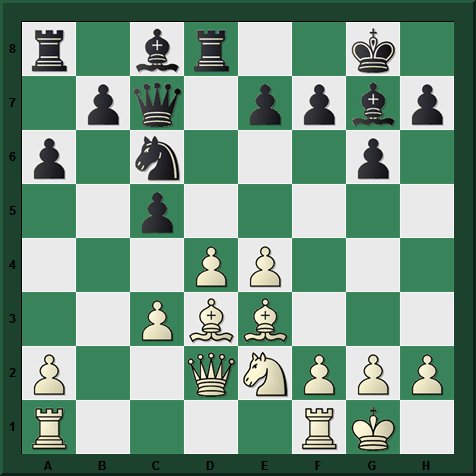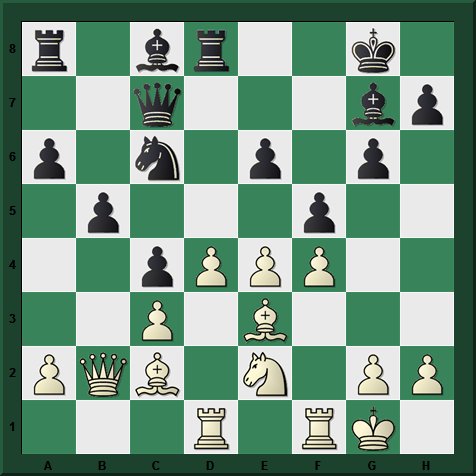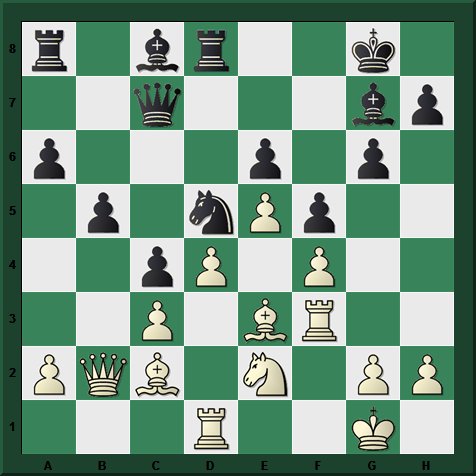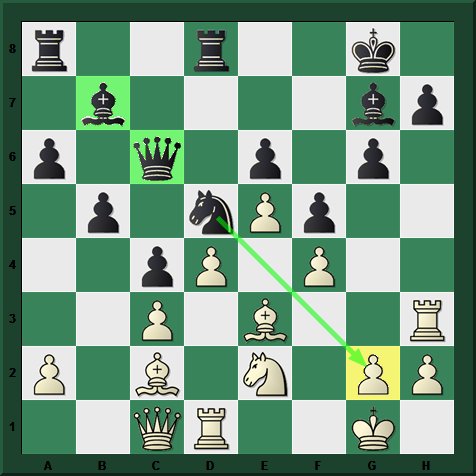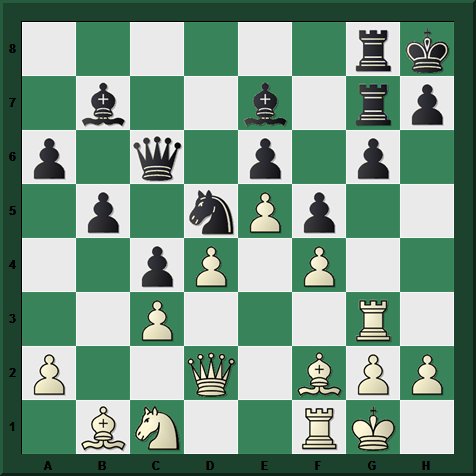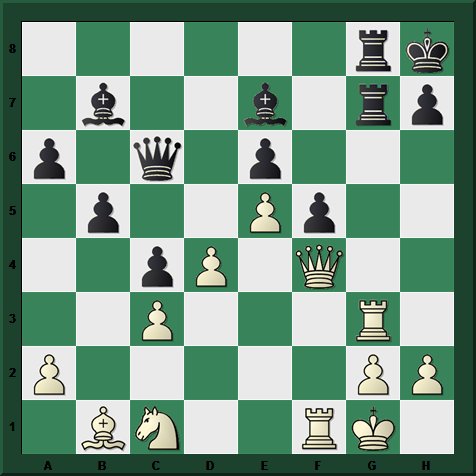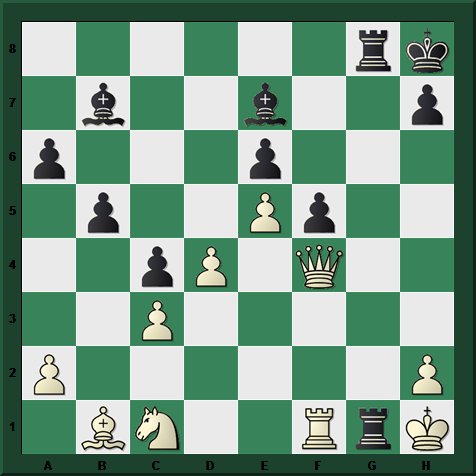All
the |
(Navigation bar
directly below.)
*******
© A.J. Goldsby, 2015.
(All rights reserved.)
****************
Click HERE
to see my
Chess Items.
****************
****************
Buy a book
from Amazon.com
(And help me out as well!)
****************
Click HERE
...
to see a list of the businesses that help to sponsor all of
my chess efforts.
|
|
|
To be honest, I thought that I played pretty badly at the New Orleans tournament ... I wound up losing two games and losing rating points. I (first) did this game primarily for my Tuesday chess class. After I posted a video on this game, (on the YT channel); the response/feedback was very positive, several people requested that I turn this game into a web page ... so I did. I also tried to make it a teaching tool, showing all the best lines in this system. There will be a box - after the game - which gives a number of games that I think are relevant to this opening. ALSO - whenever possible - I will link to these games (on the CG website) so that you can replay (study) these games, if you like. Please ... Enjoy! (E-mail me with your comments / ideas / feedback.) |
|
Click HERE to see an explanation of the symbols that I commonly use when I annotate any chess game. Click HERE to replay this game. (Click HERE to see a "star-dot-pdf" / Adobe copy of my analysis.) Click HERE to see my video channel on the "You-Tube" channel. (Click HERE to see my YT video on this game.) |
Saharish Satheesh - A.J. Goldsby I
|
|
|
[A.J.G.]
I thought that I would briefly make a web page out of this game ... I already made a YT video on this R4 clash, and several players have e-mailed me requesting that I turn this "gg" into a (fully annotated) web page.
This was my game from round four of the New Orleans Tournament (The Open Section) in December, 2014.
1.d4 Nf6; 2.c4 g6; 3.Nc3 d5; (counterplay)
I had not been having a good tournament, so I thought a change of pace was in order.
The last few years, I have tried
the Benko Gambit and the King's Indian as Black. Now, for this game, I decided to
revert to an old favorite. (I played the Grunfeld a great deal, especially when
I was younger. In my teens - and probably for another
20 years - the Grunfeld was my main response to 1.d4. I literally have nearly every
book ever printed on this particular opening.)
********************************************************************************************
White chooses a solid
system to meet Black's opening ... many GM's feel that it is the best system (here) for White.
(A more modern system involves 7.Nf3, and then 8.Rb1, here for White. See MCO-15 for details.)
4.cxd5 Nxd5; 5.e4 Nxc3; 6.bxc3 Bg7;
7.Bc4 0-0; 8.Ne2 c5;
9.Be3 Nc6;
10.0-0, "+/=" (Slight edge
for White.)
So far, it is all book. (The Exchange Variation of this opening.
See MCO-15, beginning with the first column on page # 634.)
|
|
r1bq1rk1/pp2ppbp/2n3p1/2p5/2BPP3/2P1B3/P3NPPP/R2Q1RK1 b - - 0 10
This position is well known
to theory, having been played literally thousands of times.
(Bobby Fischer played this line against Boris Spassky ... and lost!)
IF you are interested in learning this opening, I suggest getting a good DVD on these lines.
[
Interesting is the ultra-sharp attacking line of: RR
10.h4!?,
"--->"
White goes for a quick knockout on the K-side. ]
10...Qc7; (origin?)
The Smyslov System. (The great Bobby Fischer also played this line.)
This type of game is different ... (than the main line that is reached after swapping Pawns on d4, and then Black plays the try 11...Bg4.); to me, it features less emphasis on all-out tactical battles and more strategy ... and also features a lot of White attacking on the K-side, while Black usually plays on the Q-side.
[
For something like 30 years, ...
(from around the 1940's until the 1970's & beyond);
... the key idea for White was to sacrifice an exchange:
RR
10...Bg4; 11.f3 cxd4;
12.cxd4 Na5;
Two of the greatest players of all time ... ... ...
Garry Kasparov (as Black) and GM Anatoly Karpov (as White) reached this
position in several of their games, with a few coming in World Championship
matches! (A.K. did NOT! play the Exchange sacrifice,
however.)
13.Bd3 Be6; 14.d5 Bxa1;
15.Qxa1, '~' ("comp")
White has good play for
the material invested.
(GM S. Gligoric was a big exponent of this line in its early days. I remember
seeing a nice game where "Gligo" as White had crushed another player.
Yet, when I went looking for that game, I could not find it.)
[ See MCO-15, page # 634; esp. column #03 and all the notes that apply
to this particular line. ]
The most famous game ... which is one of the most recent ... would have to be:
GM Veselin Topalov (2783) - GM Alexei Shirov (2715);
[D89] /
ICT / CORUS,
GM "A" (R#4) Wijk aan
Zee, NED, 2007.
{White won an ultra-brilliant game in just 41 total moves.}
]
After Black plays his Q to the c7-square, if White is not careful, he can lose a Pawn, due to his hanging Bishop on c4.
11.Bd3, (Re-deploy.)
White decides to save his Bishop and remove it from its exposed position.
(It is not a bad move, the engine says that White still has a tiny edge here.)
[
Probably better was:
(>/=) 11.Rc1,
"+/=" (A small, solid
plus for White.)
which is the main line.
(See
any good book on the Grunfeld, my favorite is the
one
by William R. Hartston ... especially for these older lines. ]
11...a6; (space)
Black goes for a plan that allows him to grab some extra room on the Q-side.
********************************************************************************************
If I had been White, I would have thought about playing a2-a4.
(The engines prefer moves like Rc1 or Qc2.)
12.Qd2 Rd8; (center + pressure)
Black pins the QP.
|
|
r1br2k1/1pq1ppbp/p1n3p1/2p5/3PP3/2PBB3/P2QNPPP/R4RK1 w - - 0 13
Now the correct plan was probably for White to bring both Rooks to the center of the chess board.
13.Qb2!?, (The plan?)
This is not a bad move, as White steps out of the pin on the d-file. However, it is slightly awkward,
and the first player's Q is not on its best square here.
[ Best was:
>/=
13.Rac1,
"+/=" (A small, solid
plus for White.)
Nearly all the engines prefer this move for White. ]
13...b5!?; (hmmm)
Black could have won a Pawn here, but if I had done so, I would have allowed White a
tremendous amount of play.
[After thinking for a little bit, (maybe 5-10 minutes); I decide not to grab the tempting button on d4.]
[
The engines like the line:
>/= (RR)
13...cxd4!;
14.cxd4 Nxd4; 15.Nxd4
Qd6; '/+'
and Black has won a Pawn. (After he wins back
the piece.)
( However, after the
following continuation:
15...Qd6;
16.Bc4! Bxd4;
17.Bxd4 Qxd4;
18.Qb3! Rf8;
19.Rac1! Qxe4; 20.Rfe1, '~'
("comp")
White can win back one Pawn ... and has all the play.
(Right or wrong, I did not like this position for Black.
My experience, is that +1 Pawn can have little value
in heavy piece endings, especially with the Queens
still on the board. And after analyzing with the
engines,
it turns
out that White maintains a strong initiative
for many more moves.)
)
]
14.Rad1 c4; 15.Bc2,
The Bishop looks good here, but it would have been better to simply place it on b1.
(On that square, it holds the a-pawn and also supports White operations on the King-side.)
Additionally, the WQ is further shut out of the game with the WB on the c2-square.
(The engines still see this position as being equal, however.)
If you look up many GM's games in the DB, you will find a good number of games, where White won,
with the LSB on the b1-square.
[ I prefer: >/= 15.Bb1!, With the idea of … Qc1, etc. "+=" ]
15...e6; 16.f4 f5; (prophylaxis)
I have a lot of experience in this variation, having played it since I was a a much younger person.
Not only this, in similar positions, all the textbooks will tell you that when White plays f2-f4, it is usually best for Black to play ...f5; himself. (For one thing, it prevents White from getting a strong attack with an eventual f4-f5.)
|
|
r1br2k1/2q3bp/p1n1p1p1/1p3p2/2pPPP2/2P1B3/PQB1N1PP/3R1RK1 w - f6 0 17
We have reached a critical position ... for both sides. Further, White is at a nexus and must choose a good idea ... his decision here will greatly impact White's play ... for the rest of the entire game.
[ My engine likes: (>/=)
RR 16...Qa5!?; '=/+' (w/
an edge for Black.)
- Deep Fritz 14. ]
17.e5!?, (A doubtful idea?)
My opponent was a quiet and shy young man, (with very good manners); but he did not talk that much after the game.
We went to the analysis room, and I began explaining why I did not like this move (17.e5-e5) for White. Another player spoke up and said: "It's a great move, White gets a solid space advantage, a possible K-side attack and the Black KB (on g7) is shut out of the game." Then he fired his chess app on his smart phone to prove his point ...
All this aside:
#1.) GM V. Smyslov said that (in similar positions) that this is a dubious idea for White.
#2.) Black's LSB might be temporarily blocked out, but it can re-deploy to other diagonals.
But the way I see things, all of White's minor pieces (now) have little or no play...
and the White Queen on b2 is in virtual exile.
#3.)
Black gets the d5-square for his Knight and will dominate the long diagonal (from-a8-to-h1) as a result.
[ Definitely better was:
>/=
17.a3!, "+/="
when White has the slightly better position here. ]
17...Ne7!; 18.Rf3 Nd5; "=/+"
The Knight reaches its ideal square and dominates the center from its current perch.
|
|
r1br2k1/2q3bp/p3p1p1/1p1nPp2/2pP1P2/2P1BR2/PQB1N1PP/3R2K1 w - - 0 19
All the engines see this position as being (at the very least) slightly better for Black ...
despite White's large edge in K-side space.
19.Qc1 Bb7; 20.Rh3 Qc6;
An easy move to play.
|
|
r2r2k1/1b4bp/p1q1p1p1/1p1nPp2/2pP1P2/2P1B2R/P1B1N1PP/2QR2K1 w - - 0 21
Now Black threatens ...NxB/e3; followed by ...QxP/g2# mate.
********************************************************************************************
White's next move looks to be forced. However, after White played it, I did NOT have a clear idea of what I should be doing and took a really long time, (at least 30 minutes); to decide what I needed to play next.
21.Rg3[] Kh8!!; (Why?)
Black's plan goes something like this:
#1.) Get the
Dark-Squared-Bishop (DSB) out of the way.
#2.) Double Rooks on the g-file.
#3.) Bring the DSB back to the e7-square.
#4.) Play ...g7-g5; and try to make something happen on the King-side here.
Of course, this all sounds lovely, but I had to make sure that White doesn't mate me or win material while I am trying
to carry out this grand scheme.
Funnily enough, the engines do NOT prefer my move, but like
...a7-a5; instead.
(I felt that I always could come back to the Q-side, especially if we reached a stalemate on the K-side.)
[
The engine likes: (>/=)
21...a5!;
'/+' (A solid plus for Black.)
with the plan of Q-side expansion ... ... ... ]
22.Qd2 Bf8!; (re-deploy)
As per my grand scheme, I immediately begin to get my DSB out of the way ...
Strangely enough, several of the best chess engines do NOT choose this move for Black!
(Maybe the engines prefer other moves here, but I still like my idea as best.)
[
RR
22...a5!?; - Houdini 4.0
(Maybe 22...a5!)
(One of my former students - lives in CA now - has a new computer
and Houdini 4.0. I sent him the PGN for this game and he was kind
enough to do an analysis of this game ...
which ran almost four straight days.) ]
It now becomes obvious ... (to me, at least); that White has a difficult time coming up with a positive plan and is reduced to just shifting his pieces around and waits to see what Black is going to try and do. (I am sure that all of this was a direct consequence of White's questionable 17th move.)
23.Nc1 Ba3!; (restriction)
In many lines, White (if given the chance) will play a2-a4 to gain some space, open lines, and get a little play.
(So Black does everything that he can to prevent this from happening.)
I had thought about letting White get a2-a4 in, but in the long run, I think that trying to suffocate all of the first player's counterplay has got to be the best overall strategy. (And for once, DF and "The big H" actually agree with me!)
24.Rf1 Rd7!; (consistent)
I play for the K-side, although many of the best engines choose 24...b5-b4; here instead.
(24...b4!; was also a very good move and gave Black great play.)
25.Bf2 Rg8; 26.Be1 Rdg7!;
I teach all of my students to make a plan ... and then stick to it.
(This prevents the kind of vacillation that I see in many of my students games ...
it is almost that many fear to commit to ANY plan!)
Nonetheless, the idea of 26...a6-a5! followed by ...b4; also great appealed to me.
[ RR 26...b4; - DF 14. ]
As ugly as it might be, White should seriously consider playing h2-h4, to prevent Black from realizing his plan.
27.Bb1!? Be7!; 28.Bf2,
Too late, White now decides (after much thought) that he should try to prevent Black from playing ...g6-g5.
(Explanation: White begins to shift is DSB back to
e3 in a vain attempt to slow-down/stop Black from playing
...g6-g5.)
|
|
6rk/1b2b1rp/p1q1p1p1/1p1nPp2/2pP1P2/2P3R1/P2Q1BPP/1BN2RK1 b - - 0 28
Take a look at the diagram above ...
nearly all of White's pieces rest on bad squares, where they have little effect on the position ...
or restrain Black from carrying out his grand design.
[ RR 28.Bc2 g5!; "--->" (Black has a powerful attack.) ]
28...g5; 29.Be3!? Nxe3; 30.Qxe3 gxf4; 31.Qxf4,
White's last move looks logical ... the only alternative was to lose material.
|
|
6rk/1b2b1rp/p1q1p3/1p2Pp2/2pP1Q2/2P3R1/P5PP/1BN2RK1 b - - 0 31
Now Black has many good moves here ... but what is the best way to finish?
[ The box shows that the only way to prevent mate was to play:
>/=
31.Qe2 fxg3; '-+'
(Black is winning, easily, here.)
but White - as he is a whole Rook down - could easily resign here.
]
The position is (now) a chess problem ... "Black to move and win."
(31...RxR/g3; was a good move and might even compel White to quit.)
31...Qxg2+!; (Best!)
The engines confirm that this is the best move for Black. (I play for mate!)
White
(now) has no choice, he must capture my
Queen.
(Otherwise, it would be mate.)
32.Rxg2 Rxg2+; 33.Kh1 Rg1#. (Mate.)
White had no real choice the last few moves ...
|
|
6rk/1b2b2p/p3p3/1p2Pp2/2pP1Q2/2P5/P6P/1BN2RrK w - - 0 34
The final position clearly illustrates the power of the double-check!!!!!
(This was one of the few bright spots in a tournament where I played a couple of games really badly ...
and wound up losing rating points.)
In the end - I think that White mostly lost this game when he pushed his Pawn to e5.
(Even the engines have trouble finding decent moves for White after a very short amount of time.)
Copyright (c) A.J. Goldsby, 2014. All rights reserved.
Copyright (c) A.J. Goldsby, 2015. All rights reserved.
0 - 1
Relevant Games ...
on this opening
system.
|
The analysis for this page was prepared with the
excellent program,
ChessBase
10.0. (I also have CB 11 and CB
12.)
---> My
main engine - for this game - was Deep Fritz 14. (I
have a lot of confidence in this engine.)
I also - routinely
- check my analysis with the following programs: Houdini 3.0, Rybka 4, Fritz 13
and Deep Shredder.
The HTML was polished with several different tools and programs, (mostly FP) ... the text was checked for spelling with MS Word.
If you enjoyed this web-page, please e-mail me any comments!
|
Go ... or return ... to my Home Page for this site. Go (or return) ... to my "Annotated Games" (II) Page. Go
... or return ... to my "Best
Games" Page. ******* Copyright
(c) LM A.J.
Goldsby I ******* This
page was first generated in: (late)
February, 2015. |

